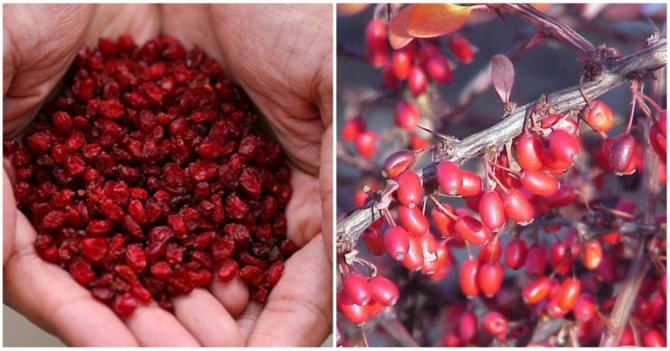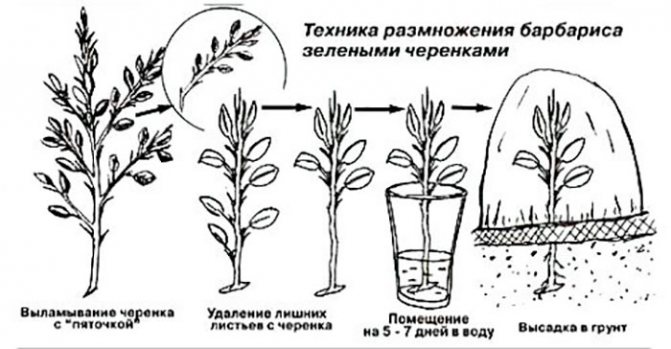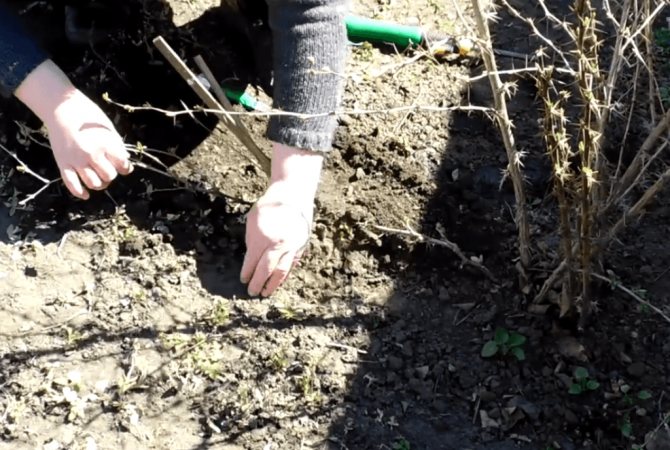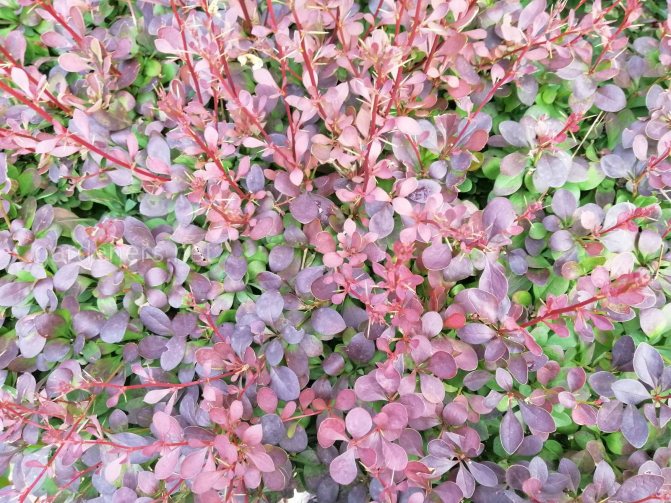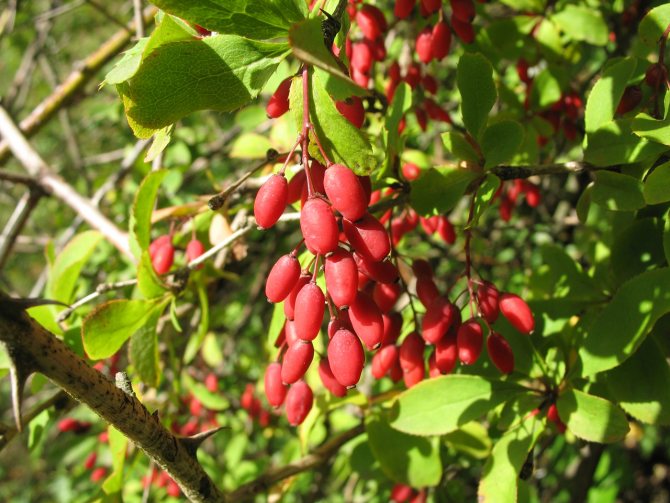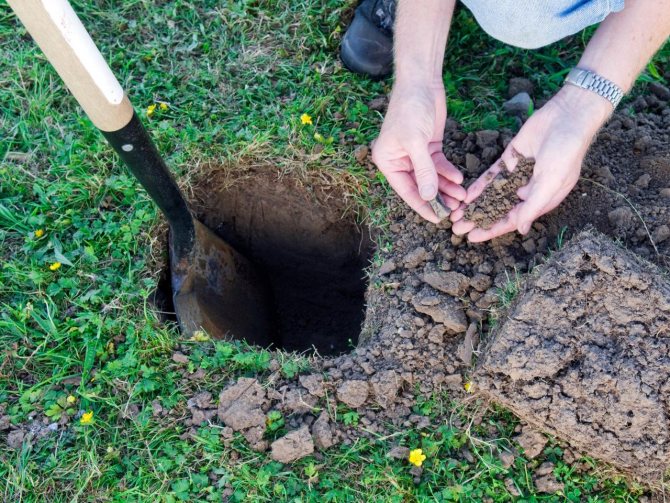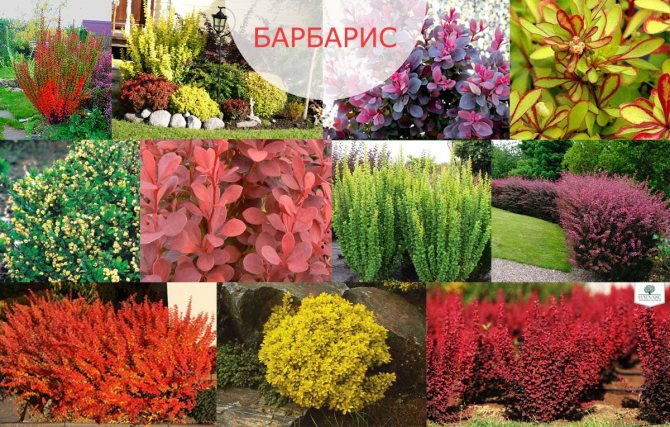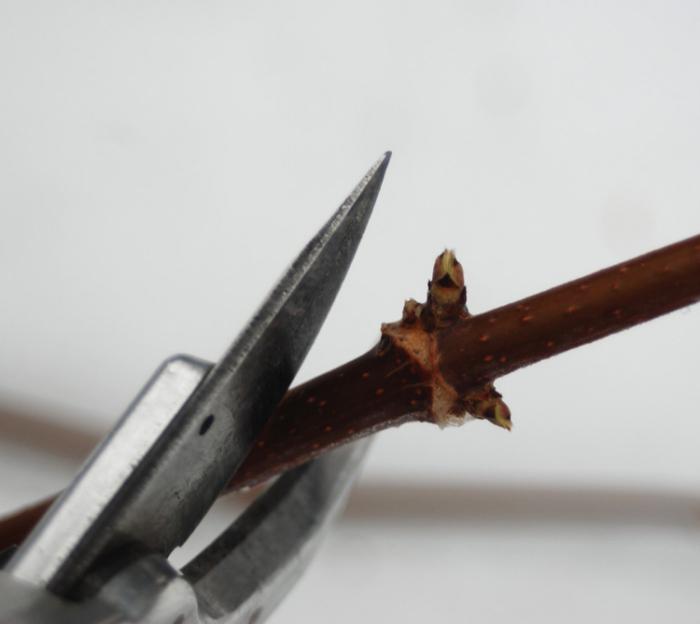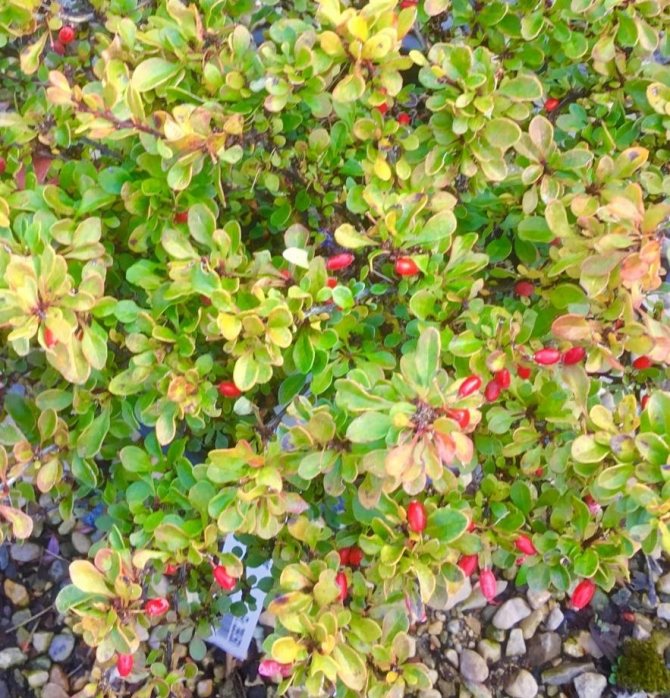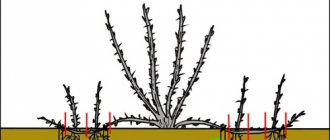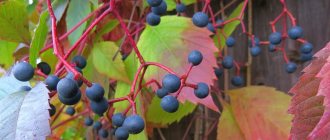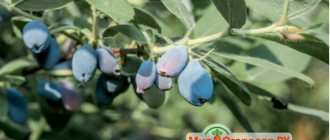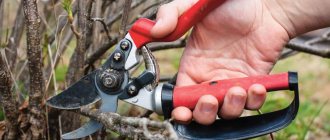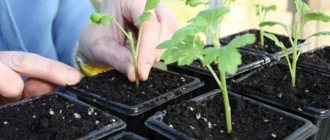Thunberg barberry (Berberis thunbergii) is the most famous species in culture after common barberry. His homeland is Japan and China.
It is small in height (up to 1 m), can reach 1.5 m in diameter and is distinguished by dense horizontal branching.
Leaves are graceful, small, 1-3 cm long, bright green in summer and fiery red in autumn, fall in October. Abundant flowering, annual, from 5 years of age, in the first half of June. It is often used in urban landscaping. This barberry looks very beautiful in a loose planting on the lawn (1-3 copies are enough), but it can also be used in a trimmed hedge, when creating low curbs, landscaping paths. Unlike common barberry, it is highly resistant to fungal diseases. It can also be planted to anchor the soil. With a single planting, the distance between the bushes is at least 1.5 - 2 m.
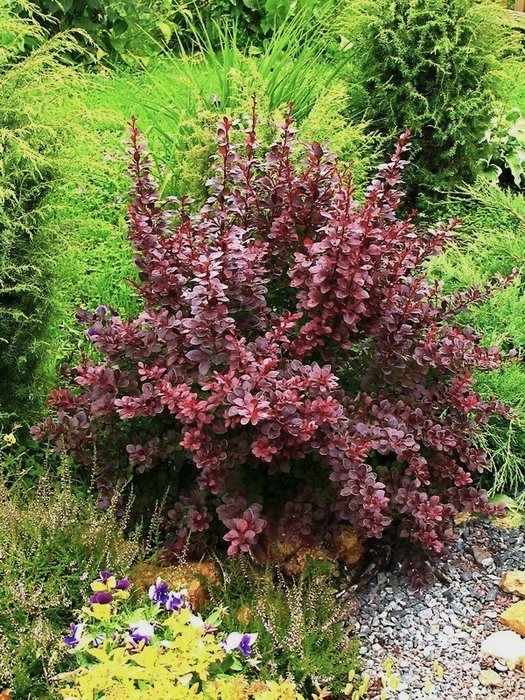
When landing
a dense single-row hedge is placed 4 copies, a two-row - 5, in a freely growing hedge barberries are planted at the rate of 2 per 1m2. The shrub can withstand a wide range of soil acidity: from acidic to neutral, but still prefers neutral. The optimum soil acidity is pH 6 - 7.5. Soil mixture: garden soil, humus, sand in equal amounts (1: 1: 1). When planting in acidic soil, liming is necessary (300 - 400 g of slaked lime or 200 g of wood ash per bush).
Top dressing
give starting from the second year after planting. In the spring, nitrogen fertilizers are applied (20 - 30 g of urea per bucket of water). Then fertilized every 3 to 4 years. It is necessary to apply complex fertilizers with microelements, for example, kemiru-wagon. Water once a week. Frequent loosening and weeding is required. After planting, mulching is carried out.
Multiply
barberry Thunberg with seeds, the viability of which is more than 90%, as well as cuttings and division of bushes.
The signal for harvesting green cuttings is a change in the color of their lower part - this is the beginning of the lignification process. To obtain green cuttings, leafy shoots are used, extending from last year's branch to the side. Cuttings easily break off at their base with a small area of the old shoot - "heel". The length of the cutting should be between 10 and 20 cm, depending on the type of plant. After separating the cuttings, the leaves are removed from their lower part. Since young shoots are still very weak, separation from the mother plant is a shock for them. If they are immediately placed in the ground, they will wither, since they will not be able to independently extract water from the soil. Therefore, you should give them time - place the lower part of the stem 3 - 4 cm in a container with water and put it in a warm, bright place, for example, in a greenhouse with cucumbers. Pruning
consists in the annual removal of weak, poorly developed shoots. Old bushes are thinned out in the spring. When arranging hedges, pruning is carried out in the second year after planting, cutting from 1/2 to 2/3 of the aerial part. Then, in subsequent years, pruning is carried out 2 times a year: in the first half of June and at the beginning of August. Low-growing forms of barberry can not be cut, they are well suited for dividing a garden plot into zones.
They are unpretentious to soil conditions, they are drought-resistant, they do not tolerate stagnant moisture at all, they develop better in the light, but they also tolerate some shading. Most of the barberries are very decorative and are used in single or group plantings, hedges, and undersized species - on rocky hills and in the form borders.
The bright autumn color of leaves and fruits that persist for a long time on the bushes further enhances their decorative effect.They tolerate urban conditions well and are easy to mold.
In recent years, many gardeners have been fond of growing barberry on their plots. The bush is beautiful. It makes an excellent living fence along the path, near the house, in the garden. The hostesses will be happy to make a lot of delicious barberry jam.
Propagation by cuttings in a plant is especially effective. Having started only 1 bush, it will soon be possible to supply all neighbors and relatives with barberry, or to plant bushes along the street.
It is easy to propagate a plant by cuttings, you just need to delve into the technology. Consider how cuttings are grown in spring and summer?
It is necessary to take into account what time of the year, what age the branches from the bush and they are propagated in 2 main ways:
- in the autumn period - lignified cuttings;
- in the spring or summer with the help of young branches.
Thunberg barberry grows as a bush. Its branches are high, they can grow up to 2.5 m. This shrub comes with yellow or red leaves, which is very beautiful. The owners specially plant such bushes to decorate their yard and vegetable garden.
Barberry from this variety is not eaten. It is customary to plant a shrub where there is a threat that the slope or ravine will begin to slide. This species is bred by cuttings, but propagated by growing from seeds, seedlings.
How barberry reproduces
The barberry shrub is distinguished by its decorativeness and delicious berries. It is planted as a hedge and to attract bees to the site. The desire of gardeners to independently breed barberry is quite understandable, especially since it is not difficult at all.
Wild barberry bushes reproduce well by self-sowing, and after a few years they completely fill the site. For cultivated forms, there are several main ways:
- obtaining root growth;
- bends;
- grafting.
In addition, the ornamental shrub propagates by seed, but this is the most difficult method that requires knowledge and skills.
Important! Rooting barberry cuttings is the easiest and most affordable method that is suitable for novice gardeners.
How to propagate barberry by cuttings
Cuttings of barberry can be carried out in summer, autumn or spring. However, green shoots cut early in the season root better than others. The survival rate of the planting material is almost 100%.
Lignified cuttings are cut in early spring before the buds swell or after leaf fall. It is not so easy to root them, the survival rate is 85-90%. However, the advantages of such cuttings are obvious - shoots grow quickly, in the future they bloom profusely and bear fruit.
In addition, this method of reproduction allows you to obtain planting material that fully retains all the varietal characteristics of the mother plant. For hybrid forms of shrubs, this is the best fit.
How to propagate barberry cuttings in summer
Planting material for propagation is cut from completely healthy bushes that grow and develop well. This is the only way to get high-quality seedlings that will give a noticeable annual growth and tasty berries.
Reproduction of barberry is possible by cuttings from the shoots of the current year, which are cut in early summer. The branch is ready for grafting if the bark on it is light green.
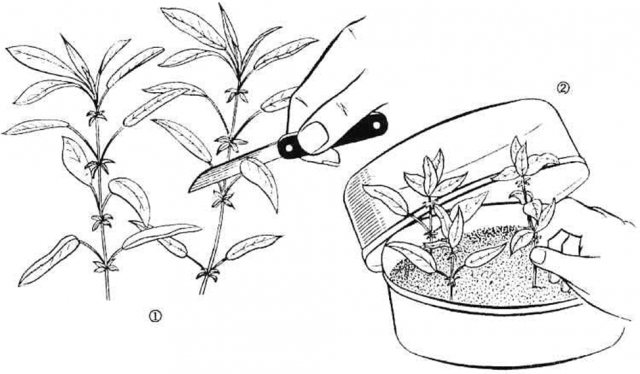

Planting instructions:
- Planting material is harvested from the middle of the shoot. A good stalk is no more than 10 cm long and has 2-3 internodes.
- The lower cut is made directly under the kidney, and the upper edge is cut 2 cm higher.
- The upper leaves are shortened so that they do not evaporate moisture, and the lower ones are removed completely.
- For reproduction, prepared shoots are planted in a greenhouse or boxes for rooting. The lower edge is dusted with Kornevin powder or another growth stimulant.
- The shoots are deepened by 2 buds. Landing is done obliquely, at an angle of 45 °.
Rooting takes from 1 to 1.5 months.All this time, the plantings need to be properly looked after: maintain soil moisture, temperature and create diffused lighting.
Advice! To prevent the cuttings from rotting, they are sprinkled with a thick layer of washed river sand. Every day the greenhouse is opened for ventilation.
When new leaves appear on the shoots, one can judge the success of reproduction. Further care of young plants includes regular watering, weeding and feeding. By the fall, full-fledged seedlings grow from the shoots, which are ready for transplantation into the garden next spring. Young bushes overwinter under good cover, since their root system is not yet sufficiently developed.
Propagation of barberry by cuttings in autumn
Experienced gardeners practice barberry propagation at home with lignified cuttings. They are cut in the fall and stored until spring in the basement, where the temperature does not drop below + 5 ° C. So that the planting material does not deteriorate, it is wrapped in a wet cloth, if necessary, it is additionally moistened. Cuttings are cut from the shoots left over after pruning the shrub. Choose healthy branches that are not affected by diseases and pests, the diameter of which is not more than 1 cm.
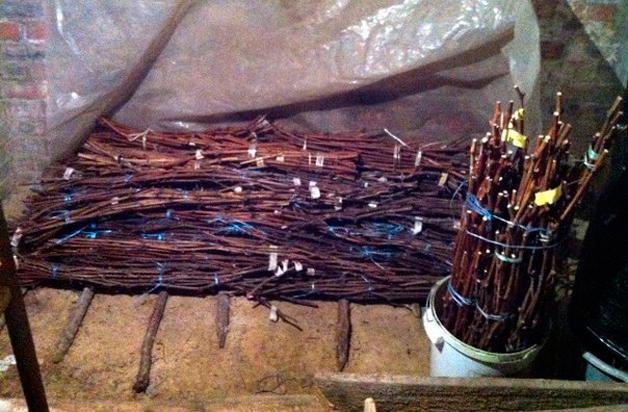

In the spring, planting material is taken out, examined, dry shoots are discarded, planted on a prepared school bed or in glasses. The soil will need loose, moisture-consuming, nutritious. Store soil for seedlings or garden soil, which is enriched with humus, peat, and loosened with sand, are suitable.
Instructions for breeding in glasses:
- Prepare containers in advance: wash, disinfect, dry.
- Make drainage holes at the bottom, fill a third of the container with expanded clay or other material.
- Pour the soil into glasses so that 1.5-2 cm remains to the top. Water well.
- To deepen the cuttings by 2 buds into the ground, tamp them around, water.
Cover the containers with a bag to create a greenhouse effect, but open every day for ventilation. If this is not done, then the cuttings will rot. After 1.5 months, young leaves will appear from the buds, remove the package completely. Further, barberry seedlings are planted in a school garden bed, where they will grow up.
After cuttings and successful rooting, barberry seedlings are transferred to a permanent place in the fall for the 2nd year of cultivation. For the winter, young bushes must be covered.
Attention! They begin to insulate the barberry when the temperature outside drops to -2 ... -5 ° C.
Propagation of barberry by cuttings in spring
If there is nowhere to save the shoots until spring, then for reproduction they are cut in early spring, until the buds swell. They take root worse. Before planting, barberry cuttings must be kept in water with a growth stimulator for 6-8 hours.
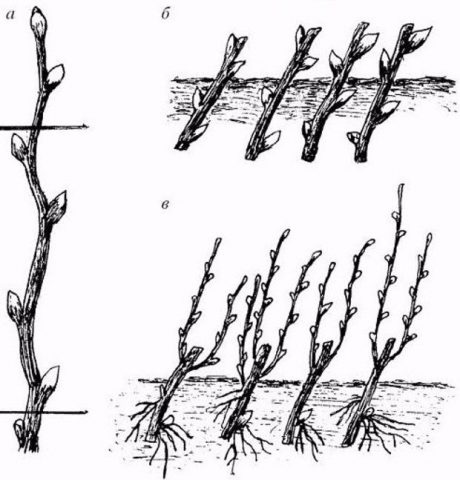

Planting material is rooted right in the garden bed. They are planted obliquely, 15-20 cm are left between the shoots. The soil is watered abundantly, mulch and cover the planting site with a film. Roots are formed in 1-1.5 months. From time to time, the greenhouse is ventilated. When young leaves appear, the film is removed, the seedlings are well looked after. During the period of active growth, they are fed with nitrogen fertilizers or organic matter. A year later, they are transferred to a permanent place.
Summer cuttings technology
It is best to start work in the first weeks of June. First, the planting material will need a greenhouse. Preparation for plant propagation should start from it:
- The basis is compost, forest litter or rotted foliage mixed with soil with a layer of 10-15 cm.
- Above - a layer of river sand about 4 cm thick.
- Tamp the substrate with a board. Water thoroughly.
- Cover with glass or plastic.
Advice. The height of the greenhouse cannot be more than 40 cm. With such parameters, it is easier to control the temperature and humidity.
The disembarkation procedure consists of the following steps:
- Plant the shoots at an angle. Depth - 0.5 cm.
- A distance of 5 cm must be observed between them. The row spacing is 7 cm.
- Water the planted cuttings. Gardeners recommend using a spray bottle or watering can. Water heating - within + 20 ... + 25 ° C.
- Close the greenhouse. Place the glass frames on top. They should be covered with burlap or tarpaulin.
Advice. The optimum air temperature for barberry is the same + 20 ... + 25 ° C. Use straw mats to protect plants from nighttime cold snaps.
The humidity inside the greenhouse should always remain high, therefore, in the first months of plant life, you will have to do 2-4 sprays per day. On sunny days, the greenhouse can sometimes be ventilated, later the duration of the air baths is increased. Usually the procedure is done in the late afternoon, when the air heats up during the day. With the onset of August, the greenhouse is dismantled so that the plant begins to take root in the ground and get used to the night temperature drop and cool morning dew. This is the best hardening of the seedling before winter. In the spring, the cuttings will finally form as independent crops for transplantation.
Advice. In good keeping conditions, the first viable roots of a barberry cuttings can be found at the 3rd week of growing. They will fully grow in about 1 month.
How to propagate barberry seeds
To reproduce barberry in order to bring out a new variety, you can use seeds. This is a long process, its success depends on adherence to all the rules and experience of the gardener.
Planting material for propagation is obtained from overripe berries, washed and dried well. Prior to planting, seeds are stored in perforated paper bags at room temperature. Their shelf life is short, so it is better to plant in the same year. You need to start sowing when the outside temperature drops below -2 ° C.
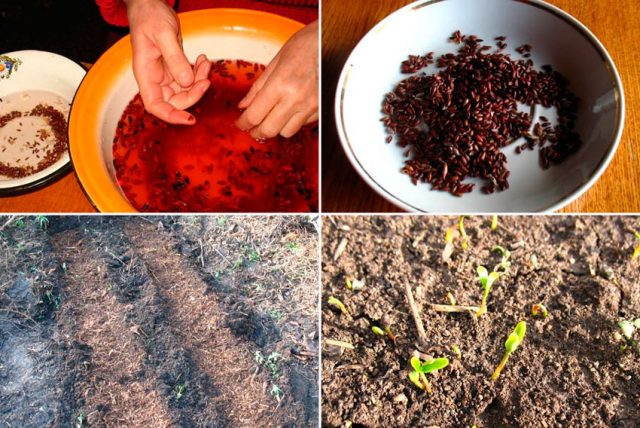

Plant seeds of barberry directly into open ground. It is best to do this in the fall of the same year, so that they undergo natural stratification.
Planting recommendations:
- A bright area is allocated for planting, where in early spring the soil will warm up well.
- The grooves are made shallow, no more than 1-3 cm. To prevent the seeds from spilling out, the holes are covered with coarse sand.
- Sowing is done sparsely, sprinkled on top with fertile soil and coniferous litter.
- In early spring, the shelter is removed, the bed is covered with a film so that friendly shoots appear.
The germination rate of barberry seeds is about 50%, so you need to sow more. Sprouts appear tight, develop slowly. In the phase of 2 true leaves, the bed is thinned out, leaving only strong plants. The distance between them is left at least 5 cm. The seedlings are transplanted to a permanent place after 2 years of cultivation.
A warning! In order for the barberry grown from seeds to start bearing fruit, it must be grafted. Flowering begins after 2 years.
Wild barberry bushes reproduce by self-seeding. Seedlings appear in early spring, in the fall they can be dug up and transplanted to a new place. Such plants bear fruit with small berries, sweet and sour taste. However, they do not need special care, so beginners in gardening prefer this method of reproduction.
How to propagate barberry by layering
If there is a decorative barberry on the site, then it can be easily propagated by layering. The procedure is started in the spring in order to get full-fledged seedlings by the fall:
- For diversion, annual shoots are chosen that bend well.
- Grooves are made around the mother bush, the branches are carefully laid in them, pinned and covered with earth. The shoot tip remains on the surface.
- The soil around the barberry is kept constantly moist so that root formation is successful.
This fall or next spring, young seedlings are dug up and transferred to the garden. By this point, they should have a good root system. Plants are placed in a well-lit place. The first few years, the seedlings are insulated for the winter.
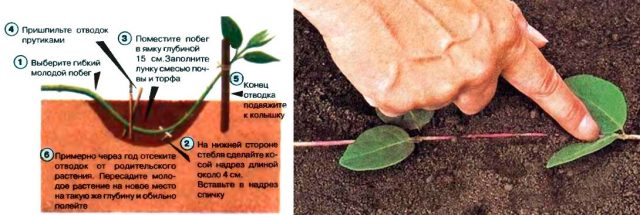

Attention! For propagation of barberry, a healthy bush is chosen by layering.The maximum number of seedlings that can be obtained in this way is no more than 5 per plant.
Planting a single plant
To plant a single plant purchased in a store, you must choose a place at a distance of no closer than two or three meters from other plants. The hole needs to be dug larger than the earthen lump of the plant itself.
It is advisable to prepare a nutrient composition from sod land, peat, humus, taken in a ratio of 2: 1: 1. Water the seedling well, carefully remove it from the container, taking care not to damage the root system.
Examine the plant carefully, if you notice damage or decay of the roots, remove this area. If there are no special preparations, treat the cut area with a solution of potassium permanganate and dust it with activated carbon.
Important! Do not deepen the growth point when planting. This will slow down the growth, flowering, fruiting of the plant, and can lead to its death.
After planting, water the barberry well and if the weather is very hot and dry, make a small shelter. After the plant takes root, the shelter must be removed. Seedlings bought in containers take root faster and better.
If you need to plant a seedling with an open root system, spread the roots well in the hole, this will accelerate the survival of the plant. Such a seedling will require more attention, and the rooting time will be longer.
How to propagate barberry root shoots
The easiest way to propagate barberry is to transplant root shoots. In spring or early summer, green growth appears around the bush, which is carefully dug up and planted. Plants take root well, by the fall full-fledged seedlings are formed from them, which in a few years will please with a full-fledged harvest.
Reproduction of barberry by shoots allows you to get planting material with exactly the same characteristics as the mother bush. However, not all varieties produce many sprouts, and most hybrid varieties do not grow at all.
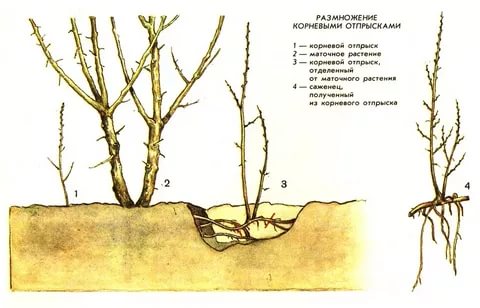

The nuances of the reproduction of the Thunberg barberry
Barberry Thunberg is the most beautiful ornamental plant with unusual color of leaves. Bushes with golden yellow, orange or purple leaves adorn the site from early spring to late autumn. Plant height can be from 20 cm to 1.5 m. Barberry bears fruit with edible sour berries.
Reproduction of Thunberg barberry is not much different from other varieties; in the summer it is easy to plant a shrub with cuttings. To do this, use the green parts of the shoots, which are planted in a greenhouse. After rooting, the film is removed. The seedlings are fully looked after, and after a year they are planted in a permanent place.
In order to guarantee the transfer of all varietal characteristics from the mother plant to the young bush, they resort to the propagation of barberry by grafting. It is made in early spring. A stalk is grafted onto a wild barberry, which has good winter hardiness.
Instructions:
- A semi-lignified cutting with a piece of bark is taken as a scion.
- A T-shaped incision is made on the rootstock directly around the bud.
- The bark is gently pushed aside and the scion is inserted there.
- The vaccination site is well fixed with a special film and covered with garden varnish.
After a few months, the success of the vaccination can be judged. Young leaves should appear on the barberry cuttings. If this is not the case, then you need to check the vaccination site.
There is another way of reproduction of Thunberg barberry - eye grafting. From the plant you like, the bud is cut off along with a piece of bark. Further, it is grafted in the same way as a stalk. The only difference is that the seedlings will develop slowly.


Decorative variety: photo, characteristics, application
Barberry is a fruiting, tree-like branched shrub that is actively cultivated by gardeners. The fruits of the shrub can be red or black, depending on the variety, and an elongated, rounded shape.Its berries are edible, have a sour taste. In addition, the plant has a dense crown and small (about 30-40 mm in length) leaves, which are thorns. In autumn, depending on the variety, the leaves of the bush change from green to purple or red. It looks especially beautiful during the flowering period.
So, barberry flowers, depending on the type of plant, can have a yellow or purple color.
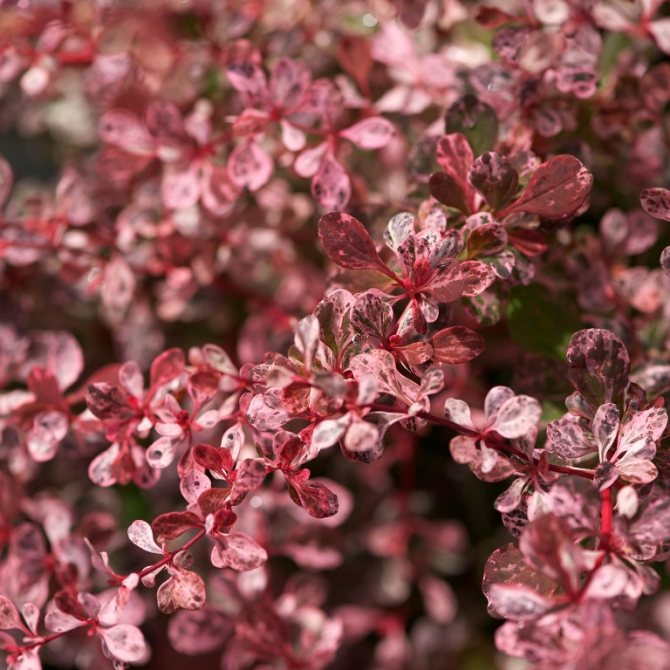

As a rule, common barberry grows in the garden up to 2.5 m in height. But, if necessary, the growth of the plant can be controlled. The shrub easily tolerates pruning and crown formation. Thanks to this, the shrub, today, is actively used in landscape design.
So, in a garden or personal plot, barberry can be used for:
- Formation of hedges;
- Decor of low wooden fences;
- Space zoning;
- Decorating gazebos.
Barberry is an unpretentious plant that grows everywhere. In Russia, the thorny shrub is grown both in the Moscow region and in the Crimea. In addition, breeders have developed special varieties that can withstand the harsh climate of Siberia and the Urals (for example, the frost-resistant variety Golden).
How to propagate barberry by dividing a bush
Reproduction of barberry by dividing a bush is not an easy procedure. The plant does not tolerate transplanting to a new place, it is sick for a long time and may die. Breeding begins in early spring or autumn, but only as a last resort. For example, if adult bushes still have to be dug up and planted, since they were originally planted in the wrong place.
Transplant instructions:
- Cut the barberry shoots at a height of 25-30 cm.
- Dig up the bushes completely and divide them into divisions with a sharp tool.
- Place the delenki in the prepared holes.
- Cut the shoots to a height of 15-20 cm.
After planting, young plants need to be well looked after. The soil is kept moist so that the bushes take root quickly.
Important! For the winter, barberry must be mulched and covered.
Site preparation and planting pit
If you plan to plant one seedling, it is enough to prepare a hole 45 × 45 centimeters in size and 50 centimeters deep. So much space is needed not only for the seedling, but also for the fertilizer that fills the space.
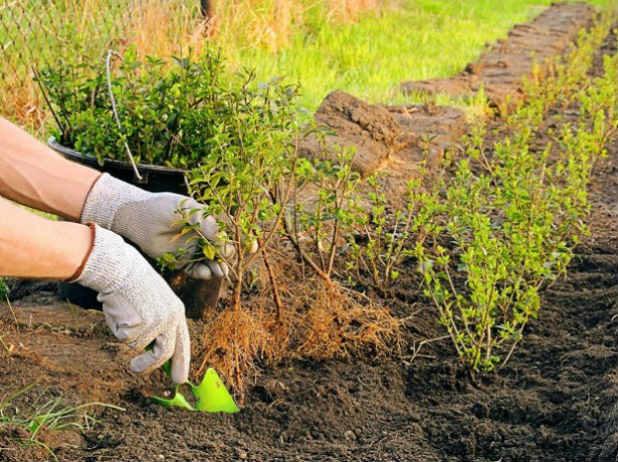

Water is poured into the resulting hole. Next, a drainage layer is laid on the bottom in the form of pebbles or pieces of wood. After preparing the pit, it is filled with a mixture of peat, soil and humus.

